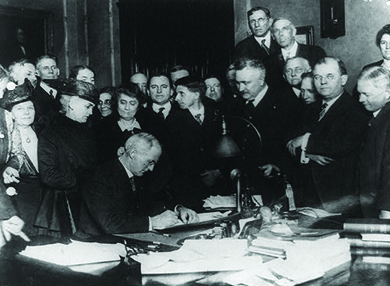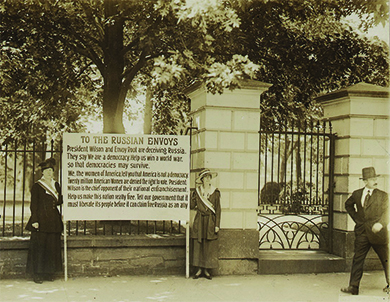| << Chapter < Page | Chapter >> Page > |
Prohibition , as the anti-alcohol movement became known, had been a goal of many Progressives for decades. Organizations such as the Women’s Christian Temperance Union and the Anti-Saloon League linked alcohol consumption with any number of societal problems, and they had worked tirelessly with municipalities and counties to limit or prohibit alcohol on a local scale. But with the war, prohibitionists saw an opportunity for federal action. One factor that helped their cause was the strong anti-German sentiment that gripped the country, which turned sympathy away from the largely German-descended immigrants who ran the breweries. Furthermore, the public cry to ration food and grain—the latter being a key ingredient in both beer and hard alcohol—made prohibition even more patriotic. Congress ratified the Eighteenth Amendment in January 1919, with provisions to take effect one year later. Specifically, the amendment prohibited the manufacture, sale, and transportation of intoxicating liquors. It did not prohibit the drinking of alcohol, as there was a widespread feeling that such language would be viewed as too intrusive on personal rights. However, by eliminating the manufacture, sale, and transport of such beverages, drinking was effectively outlawed. Shortly thereafter, Congress passed the Volstead Act, translating the Eighteenth Amendment into an enforceable ban on the consumption of alcoholic beverages, and regulating the scientific and industrial uses of alcohol. The act also specifically excluded from prohibition the use of alcohol for religious rituals ( [link] ).

Unfortunately for proponents of the amendment, the ban on alcohol did not take effect until one full year following the end of the war. Almost immediately following the war, the general public began to oppose—and clearly violate—the law, making it very difficult to enforce. Doctors and druggists, who could prescribe whisky for medicinal purposes, found themselves inundated with requests. In the 1920s, organized crime and gangsters like Al Capone would capitalize on the persistent demand for liquor, making fortunes in the illegal trade. A lack of enforcement, compounded by an overwhelming desire by the public to obtain alcohol at all costs, eventually resulted in the repeal of the law in 1933.
The First World War also provided the impetus for another longstanding goal of some reformers: universal suffrage. Supporters of equal rights for women pointed to Wilson’s rallying cry of a war “to make the world safe for democracy,” as hypocritical, saying he was sending American boys to die for such principles while simultaneously denying American women their democratic right to vote ( [link] ). Carrie Chapman Catt, president of the National American Women Suffrage Movement, capitalized on the growing patriotic fervor to point out that every woman who gained the vote could exercise that right in a show of loyalty to the nation, thus offsetting the dangers of draft-dodgers or naturalized Germans who already had the right to vote.
Alice Paul, of the National Women’s Party, organized more radical tactics, bringing national attention to the issue of women’s suffrage by organizing protests outside the White House and, later, hunger strikes among arrested protesters. By the end of the war, the abusive treatment of suffragist hunger-strikers in prison, women’s important contribution to the war effort, and the arguments of his suffragist daughter Jessie Woodrow Wilson Sayre moved President Wilson to understand women’s right to vote as an ethical mandate for a true democracy. He began urging congressmen and senators to adopt the legislation. The amendment finally passed in June 1919, and the states ratified it by August 1920. Specifically, the Nineteenth Amendment prohibited all efforts to deny the right to vote on the basis of sex. It took effect in time for American women to vote in the presidential election of 1920.

The First World War remade the world for all Americans, whether they served abroad or stayed at home. For some groups, such as women and blacks, the war provided opportunities for advancement. As soldiers went to war, women and African Americans took on jobs that had previously been reserved for white men. In return for a no-strike pledge, workers gained the right to organize. Many of these shifts were temporary, however, and the end of the war came with a cultural expectation that the old social order would be reinstated.
Some reform efforts also proved short-lived. President Wilson’s wartime agencies managed the wartime economy effectively but closed immediately with the end of the war (although they reappeared a short while later with the New Deal). While patriotic fervor allowed Progressives to pass prohibition, the strong demand for alcohol made the law unsustainable. Women’s suffrage, however, was a Progressive movement that came to fruition in part because of the circumstances of the war, and unlike prohibition, it remained.

Notification Switch
Would you like to follow the 'U.s. history' conversation and receive update notifications?